How to replace the tapered roller type wheelie hub bearing
Angular ball bearings are mainstream for bearings used for automobile hubs, because of the rigidity, maintenance-free and accuracy of passenger cars. However, this tapered roller type wheel hub bearing is used on the front side of the current 2-ton truck / bus hub, differential gear, and FR cars of some older cars. Since this bearing needs periodic maintenance, we will introduce the method this time.

Tapered roller type wheel hub bearing
By using two bubbear bearings in one hub, it can support the force in the vertical direction (radial direction) and the left-right axis direction (thrust direction) applied to the hub, so it is adopted as the front and rear hub bearings It has been. If there is no maintenance technology to a certain extent, this bearing may cause problems in reverse. In this article I will describe maintenance examples of old type passenger cars, but I think that application will be effective for the maintenance of differential gears of FR cars and also for trucks and buses of more than 2 tons used commonly Please do refer it.
What is preloading?
The tapered roller type wheel bearing needs to apply the proper “preload” (tightening torque) to the car called “preload”, and if this is mild, the occurrence of premature wear and seizure of the bearing and the like I will. Also, if the wear becomes severe, not only will the vehicle become unstable, but in the worst case it will cause impossibility of braking, locking of wheels, etc., causing a serious accident.
Wheel hub bearing backlash
The backlash of the wheel hub bearing can be understood by jacking up and rocking the wheel with it floating. In that state, remove the hub center cap, if the inside bearing is discolored, it is necessary to change the bearing. The color of grease is often black, but this color is dirty due to wear of bearings and bearings and claw washers placed in nuts, so replacing only grease is not very meaningful.
If there was a scratch that was hit on the nut side of the claw washer at the time of disassembly and maintenance, it is necessary to judge whether it is due to insufficient preload to the bearing or whether the bearing itself was worn. It is also important how the grease color changed. If there is no play in the bearing and the color of the grease is also appropriate, there is no occurrence of backlash, but I think that it is appropriate to think that the exchange of bearings is essential if it is not something you have prepared.
And, the grease to be packed in the hub here must be packed to the appropriate amount by using what is specified for the wheel bearing. If grease is put in too much, care must be taken because the grease is agitated, it will melt excessively with heat and cause burning.
How to Maintain the Wheel Hub Bearings
Here I would like to explain the Maintenance Law by taking an ordinary passenger car (FR) as an example.
Removal of outer bearings
- Grinding inspection of the bearing
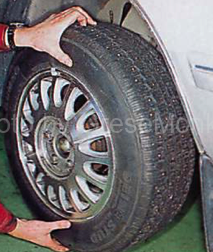

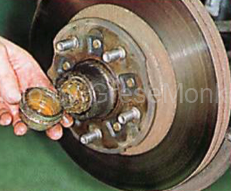
In the jacked up state, shake it by grasping the top and bottom, left and right of the tire. If you have a rough play, you can see here, but if there is a play in the state where the brake is activated, the possibility of being a backlash of the bearing is high. Also, since it is better to reuse the bearing cap, remove it with a hammer and a flathead screwdriver so as not to scratch it. Also, using the special tool “hub cap pliers” works smoothly.
- Remove bearing
When removing the bearing cap, remove the split pin with a nipper, pliers, etc., and let’s loosen the lock cap fitting in the nut. If you can, you should mark it to remember the position of the shaft and nut before cleaning the grease and loosen the nut after cleaning the grease, then the nut can be relaxed by pliers, but the nut’s Ideally you should be able to remember the degree of tightness with your sense of hand.
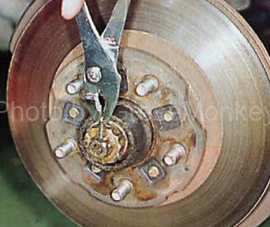
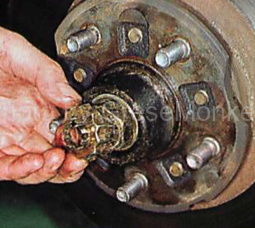
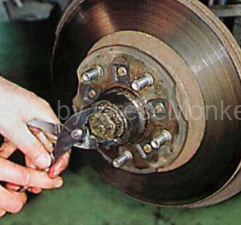

Removing inner bearing
Remove the front bearings and you can pull out the hub. It can be taken with the force of hand, but you can withdraw slowly with a puller etc. Since the oil seal is clapped inside the hub, pry it out with a flathead screwdriver or a special oil seal puller.
When the oil seal is removed, the inner bearing can be taken out. Let’s rake out the old grease that is left when removing the bearing.
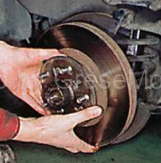
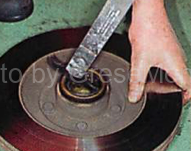
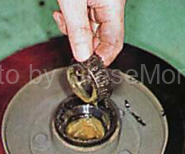
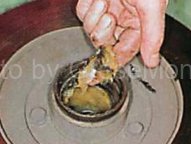
Exchange of outer race
Bash out the outer race
The outer race which is the housing of the bearing is knocked out from the inside by applying a flat punch. Depending on the vehicle, there is also a type that has a dent that becomes the position to be knocked out. Since there are two outer races on one hub, beat out the inner and outer outer races. It can not be reused.
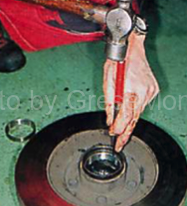

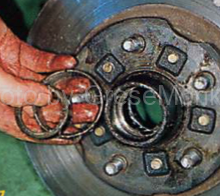
Put a new outer race
When striking a new outer race, do not hit the bearing directly, placing a flat paddle and hit it from above it is easy to drive. Also, please do not drive in one stroke and hit evenly while confirming the surroundings with the finger’s belly little by little. If you hit to the surface position with a flat paddle, please beat it deeply evenly with a flat punch or a chisel driver etc. little by little. When you finish typing, you will hear a different sound like a cancan.
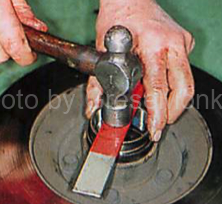

Stuff the grease
Bearing grease inside hub
After driving into the outer race on both sides, fill the inside of the hub with bearing grease. Depending on the manufacturer, there is a designation so please refer to the repair shop and use the appropriate one. Be careful not to put grease too much. As a rule of thumb, the surface position where the spindle hits is appropriate from the dent between the two outer races.
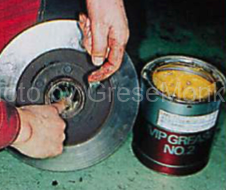
Pack grease into the bearing
When packing grease into the bearing, please put an appropriate amount of grease on the palm of the hand and rub it off with the opposite hand. At this time, please be sure to put the palm on which grease is placed on the hand opposite the dominant hand. If you do not do it, power will not enter.
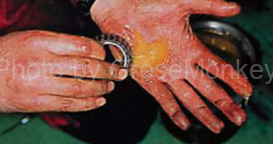
Insert grease filled bearings
Please insert it from the inner bearing first. Raise the oil seal from above and apply lubricating grease to the lip portion of the oil seal as initial lubrication. Before pushing in the hub, clean the spindle, clean the old grease, push the hub into position, insert the outer bearing and washer and set the locknut.
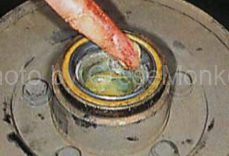
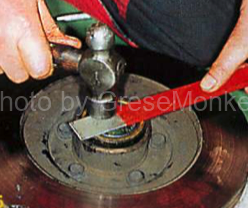
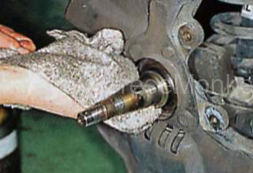
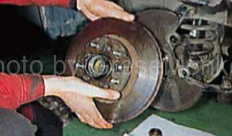
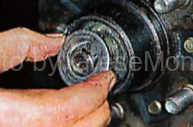
Tightening of lock nut
Preload adjustment
To tighten the lock nut, turn the hub several times while tightening the bearing with the torque of 3 kgm to calm the bearing first. After loosening it once, next time turning the hub tighten again with a torque of 3 kgm, loosen quarter turn while keeping that state.
Note: Tightening torque varies depending on the vehicle.
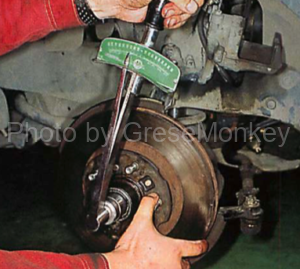
- What is preloading?
Temporarily to “give a load” to the bearing, the radial direction and the thrust direction applied to the wheel hub bearing attached to the appropriate posture position relative to the shaft. In other words, “temporarily giving the load in the vertical direction and the horizontal direction of the vehicle applied to the axis of the bearing” is called “give preload”.
Tighten rotating torque
Next, use a spring spring and tighten the lock nut a little at a time so that the load at the moment when the hub bolt is pulled at right angle from the center direction is 1050 g. Repeat this process several times.
Note: The value of the load at the moment of movement will vary depending on the vehicle.
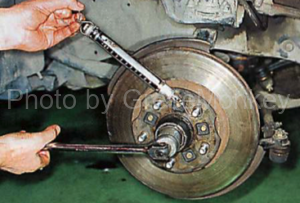
Final process
When preload adjustment is completed, perform lock cap attachment, split tweezers, hub cap grease up and installation. When that is over, finally install the wheel around the brake around. At this time, please make sure that the hub rotates smoothly or there is no play. That is all there is to it.
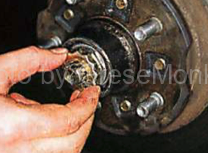
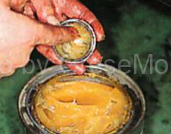
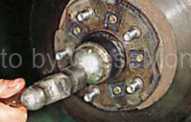

There are many other ways to maintain the wheel hub bearing, there are various ways to handle the vehicles and mechanics to handle, so it can not be said unconditionally, but as with normal bearings it is a bit difficult to control the tightening torque Maintenance such as bearing grease replacement becomes necessary for a certain mileage. In modern passenger cars this system is rarely adopted, but we can not tell you that we can not do this by developing trucks and buses. Maintenance of differential gears such as LSD is also indispensable as maintenance of “preload adjustment”, so I think that you should learn this as one of the maintenance techniques on occasion.